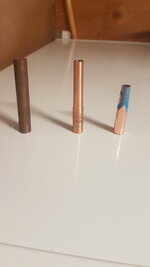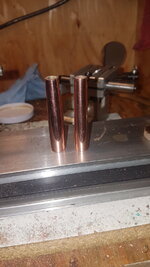Peterpasha
Member
I've only recently joined and being the sort of person who immediately jumps into the deep end, I've skipped turning wood or acrylic pens. Instead, I turn pens using copper round bar. On this particular pen, I noticed that there are tiny air bubbles trapped under the finish. I wet sand working up to 12,000 grit before putting the pen through it's patina process which takes a couple of days. After the patina process, I clean the pen's bright areas with acetone and let dry well before starting to finish. The lathe turns at around 1375rpm and I use thin CA Glue. I don't use accelerator, just letting it spin for a few minutes between coats. Each pen gets around 10 coats before final sanding and polishing. Any idea what caused these bubbles this time? Would using a heat gun between coats eliminate these?



